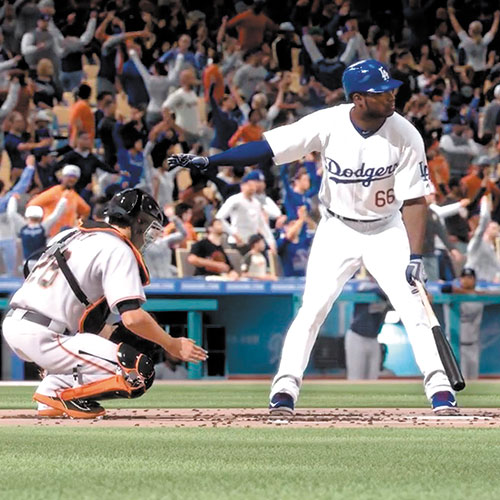‘The Show’ embodies the realism of the sport

By Andrew Reiner | Game Informer Magazine
“MLB 15: The Show”
Platform: PlayStation 4
Style: 1 or 2-Player Sports (8-Player Online)
Publisher: Sony Computer Entertainment
Developer: Sony San Diego
ERSB: E, for Everyone
The 2015 New York Yankees look like a team frozen in time. From the soon-to-be-over-the-hill Alex Rodriguez to a lineup filled with 30-somethings like Brian McCann, Carlos Beltran, and Mark Teixeira, the roster screams of yesteryear. Until these players’ lengthy contracts expire, the Bronx Bombers won’t see much young blood on the roster. This year’s “MLB 15: The Show” parallels the aging Yankees, offering a familiar package of gameplay and modes, but little in terms of exciting new content.
And that’s where developer Sony San Diego runs into a bit of a dilemma: Should the focus be on improving the foundation of modes like Road to the Show, Franchise, and Diamond Dynasty, or should more effort be applied to delivering new experiences? Seeing that this year’s top additions in “The Show” are players trotting to first base on sure outs, licensed gear, collectible loot, user-initiated cutoffs, reduced load times, and improved trade logic, it may be time for Sony to experiment again — like 2K Sports did with the story mode in its NBA series.
And why not? The core of this baseball experience is fantastic, offering a wide variety of finely honed gameplay mechanics that embody the realism of the sport. It also looks better than it ever has. New fielding animations bring exciting new possibilities to the field, like players throwing their bodies in harm’s way to knock down wild hops or doing their best Neo impressions from The Matrix to avoid getting hit by them. In years past, Sony honed in on the lifelike details for star players, bringing their stances, batter’s box waggles, and swings to the game. This year, many of these players’ personalities are included in the game, and they often add a little more excitement or tension to a particular play. Anthony Rizzo takes a few extra seconds to gloat after clobbering a ball, and Yasiel Puig always seems to be fired up. These sequences don’t occur often, but I’d recommend not pressing buttons to speed up the presentation when the game is on the line.
The improvements on the field unfortunately shine a brighter spotlight on the series’ little visual problems. After a first baseman makes a beautiful backhanded grab and control is handed to the player to run to first, the shift in weight and momentum looks awkward — like someone hit fast-forward on a DVD player. The transitional animation from a player roaring out of the batter’s box and slowing to a trot also has a little hitch in it every time. These are minor complaints, but they do stand out in a game that goes the extra mile to nail the little nuances of the sport.
On-field control offers a number of significant, little tweaks. A simplified menu for defensive shifts allows players to deploy strategies with ease. I used it for most batters. As I mentioned earlier, user-controlled cutoffs are a huge addition. Let’s say you throw the ball to home, but realize you have a better chance of cutting down a runner at second; you can tap a button to have your infielder snag the ball mid-air and hurl it to second. It’s a small addition, but a serious game-changer.
The battle between the pitcher and batter is mostly the same this year, but players have one new option to explore when standing at the dish. Directional hitting, a batting mechanic that allows players to influence where the ball is hit by looking for a specific pitch location, can be immensely satisfying … when it works. It has an incredibly low success rate, and is mostly for veteran players who are great at reading pitches. I would only switch to it when I wanted to expose a defensive shift or try to direct a bunt down a baseline. Even if you guess a specific pitch location correctly, it doesn’t work every time, mind you; timing and number crunching are factored into its success rates.
When it comes to this year’s modes, simplification is the name of the game. Franchise mode is largely the same as it was last season, but now offers a streamlined trade system boasting a handy finder option, as well as yearly goals for managers.
Transferable saves ended up being a bust for me. Yes, it’s great that you can continue a career from “MLB 14” with all of the new gameplay and graphical perks in tow, but the roster holds true to your franchise or Road to the Show career, and doesn’t accommodate the trades or signings made in the real world. I found I’d much rather have up-to-date rosters than carried over statistics.
Road to the Show is the same song and dance as last year, but does veer into the territory of fantastical magic through collectible gear that gives your player significant and immediate boosts in attributes. The gear is a part of The Show’s new collectible trading cards, which come in purchasable packs using the in-game currency. Given that Road to the Show is about honing a player’s skills through play, it’s odd that the fastest way to improve his skills is to throw on a new pair of shoes.
As Sony continues updating the legacy features of this game — tweaks that undoubtedly make the game better and more user friendly — a long-time fan of the series like me can’t help but look at the innovations occurring in other sport games and wonder why Sony hasn’t taken more chances. It’s still a hell of a game, but if you come back to it year in and year out, this season’s offering doesn’t have much of a spark.











